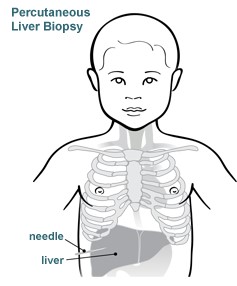Percutaneous Liver Biopsy
The term “percutaneous” means “to go through the skin.” During a percutaneous liver biopsy, a doctor places a needle through the skin of the right upper abdomen into the liver and takes small pieces of tissue to send to a laboratory for analysis.
In most cases we use this procedure to determine why a child has increased liver enzymes. Causes include hepatitis or biliary atresia, which is the underdevelopment of the bile ducts leading to the small intestine.

Procedure
Using ultrasound for guidance, the doctor inserts the needle into the liver to obtain small pieces of tissue. Then the doctor inserts a substance called Gelfoam® into the liver to minimize bleeding into the tract (where the needle went into the liver). The body absorbs the substance, which is harmless. We will put a bandage over the site of the injection. The procedure should take approximately one hour.
Anesthesia
Patients receive either IV sedation or general anesthesia and are asleep for this procedure.
Pain
Your child may have some discomfort around the biopsy site for several days that can be treated with over-the-counter pain medication.
Risks
This procedure is considered low-risk. However, potential complications include:
- bleeding
- infection
- puncture of the lung (pneumothorax or hemothorax)
- puncture of the gallbladder with subsequent bile leak
After the Procedure
Your child may experience some discomfort and will need to lie in bed for four to six hours in the recovery area. You can be with your child during this time.
After four hours, we will take a blood count (a CBC) to tell us whether there is bleeding from the liver into the abdominal cavity. Most children don’t experience bleeding. Outpatients whose blood counts are normal will be able to go home.
Leave the bandage on for 48 hours and keep it dry. After 48 hours you may remove the gauze and clear bandage but do not remove the white Steri-Strips®. If the Steri-Strips haven’t fallen off after seven days, you may remove them.
Bathing
Keep the site dry for 48 hours. After 48 hours, your child may shower or have a sponge bath, but must keep the area dry. If showering, your child must face away from the showerhead. Do not submerge the site in water (bath or pool) until the Steri-Strips have fallen off.
Activity Restrictions
Your child should rest after the procedure and can return to light activities the next day. It is important that your child avoid strenuous activity or contact sports, including rough playing, for one week.
Connect with us:
Download our App: